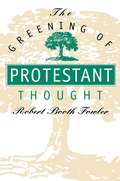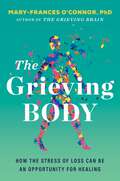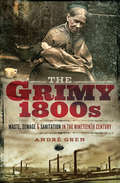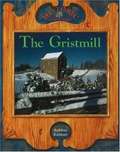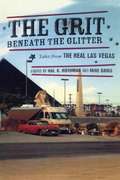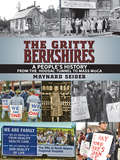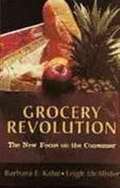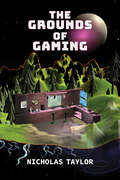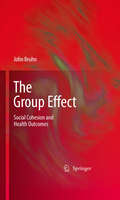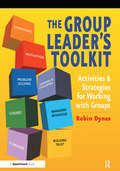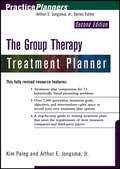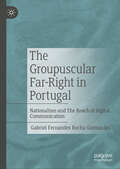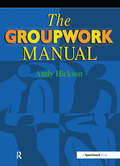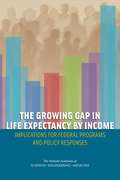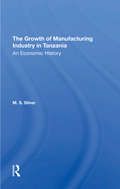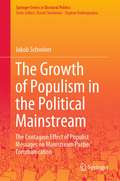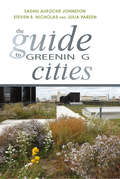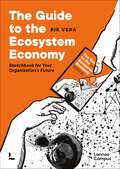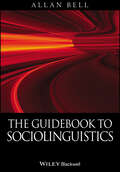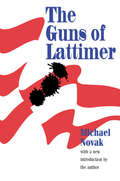- Table View
- List View
The Greening of America
by Charles A. ReichThere is a revolution coming. It will not be like revolutions of the past. It will originate with the individual and the with culture, and it will change the political structure only as its final act. It will not require violence to succeed, and it cannot be successfully resisted by violence. This is the revolution of the new generation.
The Greening of Protestant Thought
by Robert Booth FowlerThe Greening of Protestant Thought traces the increasing influence of environmentalism on American Protestantism since the first Earth Day, which took place in 1970. Robert Booth Fowler explores the extent to which ecological concerns permeate Protestant thought and examines contemporary controversies within and between mainline and fundamentalist Protestantism over the Bible's teachings about the environment. Fowler explores the historical roots of environmentalism in Protestant thought, including debates over God's relationship to nature and the significance of the current environmental crisis for the history of Christianity. Although he argues that mainline Protestantism is becoming increasingly 'green,' he also examines the theological basis for many fundamentalists' hostility toward the environmental movement. In addition, Fowler considers Protestantism's policy agendas for environmental change, as well as the impact on mainline Protestant thinking of modern eco-theologies, process and creation theologies, and ecofeminism.
The Grieving Body: How the Stress of Loss Can Be an Opportunity for Healing
by Mary-Frances O'ConnorThe follow-up to celebrated grief expert, neuroscientist, and psychologist Dr. Mary-Frances O’Connor’s The Grieving Brain focuses on the impact of grief—and life’s other major stressors—on the human body. Coping with death and grief is one of the most painful human experiences. While we can speak to the psychological and emotional ramifications of loss and sorrow, we often overlook its impact on our physical bodies. Dr. Mary-Frances O’Connor specializes in the study of grief, and in The Grieving Body she shares vital scientific research, revealing imperative new insights on its profound physiological impact. As she did in The Grieving Brain, O’Connor combines illuminating studies and personal stories to explore the toll loss takes on our cardiovascular, endocrine, and immune systems and the larger implications for our long-term well-being.The Grieving Body addresses questions about how bereavement affects us, such as:Can we die of a broken heart?What happens in our bodies when we’re grieving?How do our coping behaviors affect our physical health?What is the cognitive impact of grief?Why are we more prone to illness during times of enormous stress?and moreResearch-backed, warm, and empathetic, The Grieving Body is an essential, hopeful read for those experiencing loss as well as their supportive friends and family.The Grieving Body is illustrated with black-and-white charts and graphs.
The Grimy 1800s: Waste, Sewage, & Sanitation in Nineteenth Century Britain
by Andre GrenChronicles of the filth, foulness, and public health disasters found by &“inspectors of nuisances&” in a newly industrialized world. In the nineteenth century, as towns grew, Britain became increasingly grimy. The causes of dirt and pollution were defined legally as &“nuisances&” and, in 1835, the new local authorities very rapidly appointed an army of &“inspectors of nuisances.&” This book reveals the Victorian era from a very different point of view: it offers the inspectors&’ eyewitness accounts and details the workings of the Parliamentary Committees that were set up in an attempt to ease the struggle against filth. Inspectors battled untreated human excreta in rivers black as ink, as well as unsanitary drinking water, home to tadpoles and portions of frogs so large that they blocked taps. They dealt with putrid animal carcasses in cattle markets and slaughterhouses, not to mention the unabated smoke from mill chimneys that covered towns with a thick layer of black grime. Boggle Hole Pond was a source of drinking water full of dead dogs; ice cream was coated in bugs; stinking rotting crabs, poultry, and pigeon smells polluted the air. Even the corpses floating out of badly drained burial grounds were &“nuisances,&” leading to the practice of burning the remains of the dead. This is the history of a grimy century in the throes of the Industrial Revolution, illustrating the many ways in which the country responded to the ever growing demands of a new world.
The Grimy 1800s: Waste, Sewage, and Sanitation in Nineteenth Century Britain
by Andre GrenIn the nineteenth century, as towns grew, Britain became increasingly grimy. The causes of dirt and pollution were defined legally as ‘nuisances’ and, in 1835, the new local authorities very rapidly appointed an army of ‘inspectors of nuisances’. This book is the inspectors’ chronicle: it offers their eyewitness accounts and a plethora of details pertaining to the workings of the scrutinizing Parliamentary Committees that were set up in an attempt to ease the struggles against filth. Inspectors battled untreated human excreta in rivers black as ink, as well as insanitary drinking water, home to tadpoles and portions of frogs so large that they blocked taps. They dealt with putrid animal carcasses in cattle markets and slaughterhouses, not to mention the unabated smoke from mill chimneys that covered towns with a thick layer of black grime. Boggle Hole Pond was a source of drinking water full of dead dogs; ice cream was coated in bugs; stinking rotting crabs, poultry and pigeon smells polluted the air. Even the dead floating out of badly drained burial grounds were ‘nuisances’, leading to the practice of burning the remains of the dead. This is the history of a grimy century in the throes of the Industrial Revolution, illustrating the many ways in which the country responded to the ever growing demands of a new age of industry.
The Gristmill (Historic Communities)
by Bobbie KalmanEarly pioneers would travel from far and wide to visit the gristmill for the essential service of having their grain ground. Communities often developed in areas where gristmills had been built. In the Gristmill young readers will find out
The Gritty Berkshires: A People's History From The Hoosac Tunnel To Mass Moca
by Maynard SeiderAs The Gritty Berkshires makes clear, Massachusetts' westernmost county is not just art museums, music festivals and beautiful scenery. For generations of working class families who have lived in the northern part of this county, their reality looks more like Rust Belt America. Maynard Seider, an activist sociologist who has taught and researched in the area for more than three decades, places the history of the North Berkshire region in the context of U.S. and global history. Through the use of oral histories, union archives, newspaper accounts and participant observation, the author focuses on the 1,000 men who built the nation's longest railroad tunnel, the thousands of men and women who worked in its textile mills and electronics factories and who struck, built worker co-ops, and community coalitions to improve their daily lives. In this history, we learn how the Berkshires offer insight into so many crucial aspects of the American experience. Moving from the early 1800s to the present, Seider weaves a narrative that details the area's vibrant immigrant history, slavery's role in its textile industry, the battle for national unions and the ideological struggles with corporate elites over who best speaks for the community. Enriched by dozens of photographs, these stories focus on the voices of ordinary people as they often do extraordinary things. Seider concludes his book by considering the question of "What's next?" through a case study of the Massachusetts Museum of Contemporary Art (MASS MoCA). These brick buildings which housed generations of blue and white collar workers until 1986 now attract tourists to the country's largest contemporary art collection. Yet the unanswered question remains, can a tourist-service economy provide a meaningful and economically sustainable life for its residents? The Gritty Berkshires' last section deals with this question both nationally and locally, exploring diverse responses amidst the nation's growing inequality, militarism and cutbacks in social services.
The Grocery Revolution: The New Focus on the Consumer
by Barbara E. Kahn Leigh M. McalisterThis text provides an introduction to the understanding of changing consumer behaviour and trends in managerial practice in the grocery industry.
The Ground Between: Anthropologists Engage Philosophy
by Michael Jackson Veena Das Arthur Kleinman Bhrigupati SinghThe guiding inspiration of this book is the attraction and distance that mark the relation between anthropology and philosophy. This theme is explored through encounters between individual anthropologists and particular regions of philosophy. Several of the most basic concepts of the discipline--including notions of ethics, politics, temporality, self and other, and the nature of human life--are products of a dialogue, both implicit and explicit, between anthropology and philosophy. These philosophical undercurrents in anthropology also speak to the question of what it is to experience our being in a world marked by radical difference and otherness. In The Ground Between, twelve leading anthropologists offer intimate reflections on the influence of particular philosophers on their way of seeing the world, and on what ethnography has taught them about philosophy. Ethnographies of the mundane and the everyday raise fundamental issues that the contributors grapple with in both their lives and their thinking. With directness and honesty, they relate particular philosophers to matters such as how to respond to the suffering of the other, how concepts arise in the give and take of everyday life, and how to be attuned to the world through the senses. Their essays challenge the idea that philosophy is solely the province of professional philosophers, and suggest that certain modalities of being in the world might be construed as ways of doing philosophy.Contributors. João Biehl, Steven C. Caton, Vincent Crapanzano, Veena Das, Didier Fassin, Michael M. J. Fischer, Ghassan Hage, Clara Han, Michael Jackson, Arthur Kleinman, Michael Puett, Bhrigupati Singh
The Grounds of Gaming (Digital Game Studies)
by Nicholas TaylorHow do we make space for video games in the places where we live, work, and play—and who is allowed to feel welcome there? Despite attempts to expand games beyond their conventional audience of young men, the physical contexts of gameplay and production remain off-limits and unsafe for so many.The Grounds of Gaming explores the physical places where games are played and how they contribute to the persistence of gaming's problematic politics. Drawing on fieldwork in an array of sites, author Nicholas Taylor explores the real-world settings where games are played, watched, discussed and designed. Sometimes these places are sticky, dark, and stinky; other times they are pristine and well appointed. Situating its chapters in such scenes as domestic gaming setups, campus computer labs, LAN parties, esports arenas, and convention centers, Taylor maps the infrastructural connections between games, place, masculinity, and whiteness.By inviting us to reconsider gaming's cultural politics from the ground up, The Grounds of Gaming offers new theoretical insights and practical resources regarding how to make game cultures and industries more inclusive.
The Group Effect
by John BruhnSociologists and anthropologists have had a long interest in studying the ways in which cultures shaped different patterns of health, disease, and mortality. Social scientists have documented low rates of chronic disease and disability in non-Western societies and have suggested that social stability, cultural homogeneity and social cohesion may play a part in explaining these low rates. On the other hand, in studies of Western societies, social scientists have found that disease and mortality assume different patterns among various ethnic, cultural and social-economic groups. The role of stress, social change and a low degree of cohesion have been suggested, along with other factors as contributing to the variable rates among different social groups. Social cohesion has been implicated in the cause and recovery from both physical and psychological illnesses. Although there has been a large amount of work established the beneficial effects of cohesion on health and well-being, relatively little work has focused on HOW increased social cohesion sustains or improves health. This work is based on the premise that there are risk factors, including social cohesion that regulate health and disease in groups. One of the challenges is how to measure social cohesion - it can be readily observed and experienced but difficult to quantify. A better understanding of how social cohesion works will be valuable to improving group-level interventions.
The Group Leader's Toolkit: Activities and Strategies for Working with Groups
by Robin DynesAn essential resource for all kinds of groups, these tried and tested strategies will stimulate and encourage full participation from all group members. Provides ideas for introducing group members to each other, breaking down barriers, energising people, helping people learn, moving the group on, building trust between group members, motivating people, assessing and evaluating the group, managing behaviour and personal responsibility, and ending sessions. The activities are set out in a clear, easy to follow format, with variations and guidance for adapting the activities. Will enable group leaders to promote group members' self development, meet the needs of their different learning styles, stimulate their creativity and develop their thinking skills. This toolkit is an invaluable resource for tutors, occupational therapists, nurses, care staff, probation staff, youth leaders or anyone - new or experienced - who works with groups.
The Group Therapy Treatment Planner
by Arthur E. Jongsma Kim PalegThe Group Therapy Treatment Planner, Second Edition provides all the elements necessary to quickly and easily develop formal treatment plans that satisfy the demands of HMOs, managed care companies, third-party payors, and state and federal review agencies. A critical tool for mental health professionals developing formal treatment plans for working with a variety of groups New edition features expanded coverage and outlines entirely new areas including utilizing group therapy to treat panic/agoraphobia, PTSD/trauma, adult ADHD, obsessive-compulsive disorder, and borderline personality disorder Streamlined interventions and fully updated language make this edition easier to use and more clinically applicable Saves you hours of time-consuming paperwork, yet offers the freedom to develop customized treatment plans Organized around 33 main presenting problems with a focus on applying a group therapy approach to a wide variety of disorders Over 1,000 well-crafted, clear statements describe the behavioral manifestations of each relational problem, long-term goals, short-term objectives, and clinically tested treatment options Easy-to-use reference format helps locate treatment plan components by behavioral problem or DSM-IV-TR diagnosis Includes a sample treatment plan that conforms to the requirements of most third-party payors and accrediting agencies (including HCFA, JCAHO, and NCQA)
The Groupuscular Far-Right in Portugal: Nationalism and The Reach of Digital Communication
by Gabriel Fernandes GuimarãesThis book analyzes two types of nationalisms that are represented by the Portuguese groupuscular right, that is, the extra-party right. One faction is guided by ethnonationalism and nativism, looking at Portugal through an ethnically European prism. Small groups fight for a white Portugal linked to an imagined white world, rooted in ideas such as race and biology, following models from the US. The other faction looks for a future in a non-European confederation and wants Portuguese citizenship for non-European groups originating from the former colonies, while maintaining ties with the Portuguese extreme right, notably, the one that comes from the Salazar right-wing dictatorship (Estado Novo, 1926–1974). This faction suggests addressing questions of immigration by accepting immigration of non-European people from former imperial space and by initiating a confederation of countries, in which Portugal is the only state with a white majority. Guimarães analyzes the means of communication of these two factions, the language they use to articulate their viewpoints, and the worldviews of various groups in Portugal. He argues that the far right in Portugal is a space filled with radical styles of nationalism.
The Groupwork Manual
by Andy HicksonIntended for anyone who runs or participates in group sessions, this manual offers almost 100 practical activities. It takes the user through a broad range of exercises, ideas, pitfalls and descriptions. This is an ideal companion to the "Creative Activities in Groupwork" series. The book covers every kind of group from social to community groups and from encounter to therapeutic groups. Activities include transforming sound, singing questions, name paint, ritual teambuilding, ears, eyes and mouth, survival, my favourite words, improvisations, sharing, jungle, musical hoops, space walk and interviews.
The Growing Gap in Life Expectancy by Income: Implications for Federal Programs and Policy Responses
by Committee on the Long-Run Macroeconomic Effects of the Aging U.S. Population<P> According to many studies, life expectancy has been rising fastest for people with higher education or income, so the gap in longevity by socioeconomic status has been increasing. This trend is important in itself, but it also means that higher-income people will increasingly collect government benefits such as Social Security over more years than will lower-income people. It also means that some proposed policy changes to make programs fiscally sustainable, such as raising the normal retirement age for Social Security or raising the eligibility age for Medicare, might disproportionately affect those with lower incomes. <P><P> These topics are discussed in this report. The study first reviews the literature on differences in longevity by education and by income and on trends in these differences; the committee then constructs some new estimates of our own. Next the report discusses the conceptual background for these issues and why they are important. We go on to evaluate the way that the widening income differences in mortality affect the value of net lifetime benefits for different income groups from Social Security retirement and spousal benefits, Disability Insurance, Survivors Insurance, Medicare, Medicaid, and Supplemental Security Income. Finally, we consider how the differential changes in mortality would affect analyses of some possible reforms to government programs for the elderly in the face of population aging. We consider the consequences of policies such as raising the earliest eligibility age and the normal retirement age under Social Security, raising the age of eligibility for Medicare, basing the cost-of-living adjustment on a different kind of consumer price index, and changing the formula for how benefits are calculated for higher-income beneficiaries.
The Growth Dilemma: Residents' Views and Local Population Change in the United States
by Mark BaldassareThis title is part of UC Press's Voices Revived program, which commemorates University of California Press’s mission to seek out and cultivate the brightest minds and give them voice, reach, and impact. Drawing on a backlist dating to 1893, Voices Revived makes high-quality, peer-reviewed scholarship accessible once again using print-on-demand technology. This title was originally published in 1981.
The Growth Of The Manufacturing Industry In Tanzania: An Economic History
by M. S. Silver M S SilverTracing the evolution of the Tanzanian manufacturing industry since the beginning of colonial rule, this book focuses on the period since independence and especially on the effects of socialist policies resulting from the 1967 Arusha Declaration. Dr. Silver develops volume indices of production for Tanzanian industry as a whole and for individual sectors. He also examines in detail changes in labor productivity, earnings, unit labor costs, investments, and the prices of manufactured goods, paying special attention to the role of government-controlled parastatals, the regional distribution of manufacturing industries, and income inequality. The rapid growth in production and employment and the changing structure of the manufacturing industry, he concludes, is due to high rates of investment in a small number of relatively large establishments, primarily in the parastatal sector.
The Growth of Populism in the Political Mainstream: The Contagion Effect of Populist Messages on Mainstream Parties’ Communication (Springer Series in Electoral Politics)
by Jakob SchwörerThis book examines the populist communication of mainstream parties in Germany, Austria, Italy, and Spain. For a long time, populist and radical right parties have been the main subject of investigation in academic research. Yet, how mainstream parties react to the rise of such actors is less known. Scholars assume a “populist Zeitgeist”, a populist contagion claiming that the political mainstream actively engages in populist and nativist discourses. The author tests this widespread assumption analyzing whether center-left and center-right mainstream parties adopt populist messages, as well as content related to the leftist and right-wing host ideologies of populist actors. Therefore, this book is a must-read for scholars, students, and researchers of political science and electoral studies, as well as policy-makers and practitioners interested in a better understanding of populism and populist communication.
The Growth of Public Expenditure in the United Kingdom from 1870 to 2005
by Clive LeePublic expenditure has increased considerably in the UK from around ten per cent of GDP in the 1870s to forty per cent and above in the 21st century. Clive Lee explores the fluctuations in state spending, highlighting the ongoing political conflict over the size and extent of welfare provision.
The Guide to Greening Cities
by Sadhu Aufochs Johnston Steven S. Nicholas Julia ParzenSuperstorm Sandy sent a strong message that a new generation of urban development and infrastructure is desperately needed, and it must be designed with resilience in mind. As cities continue to face climate change impacts while growing in population, they find themselves at the center of resilience and green city solutions, yet political and budgetary obstacles threaten even the best-planned initiatives. In The Guide to Greening Cities, seasoned green city leaders Sadhu Johnston, Steven Nicholas, and Julia Parzen use success stories from across North America to show how to turn a green city agenda into reality. The Guide to Greening Cities is the first book written from the perspective of municipal leaders with successful, on-the-ground experience working to advance green city goals. Through personal reflections and interviews with leading municipal staff in cities from San Antonio to Minneapolis, the authors share lessons for cities to lead by example in their operations, create programs, implement high-priority initiatives, develop partnerships, measure progress, secure funding, and engage the community. Case studies and chapters highlight strategies for overcoming common challenges such as changes of leadership and fiscal austerity. The book is augmented by a companion website, launching with the publication of the book, which offers video interviews of municipal leaders, additional case studies, and other resources. Rich in tools, insights, and tricks of the trade, The Guide to Greening Cities helps professionals, policymakers, community leaders, and students understand which approaches have worked and why and demonstrates multidisciplinary solutions for creating healthy, just, and green communities. Visit the companion webiste to the book-http://guidetogreeningcities. org/
The Guide to the Ecosystem Economy: Sketchbook for Your Organization's Future
by Rik VeraThis is the era of the Smart Ecosystems Economy, where the companies that thrive must be ready to cope with randomness and unexpected events. In this digital world, the traditional boundaries have disappeared, paving the way for new and smarter ecosystems to develop. Companies seeking to transform into future-proof organizations would do well to understand these ecosystems, and get a grasp on how they work. This book serves as a guide to building smart, competitive ecosystems for both small and large organizations. A timely book that cracks the code of tomorrow&’s business models.
The Guidebook to Sociolinguistics (Introducing Linguistics Ser.)
by Allan BellThe Guidebook to Sociolinguistics presents a comprehensive introduction to the main concepts and terms of sociolinguistics, and of the goals, methods, and findings of sociolinguistic research. Introduces readers to the methodology and skills of doing hands-on research in this field Features chapter-by-chapter classic and contemporary case studies, exercises, and examples to enhance comprehension Offers wide-ranging coverage of topics across sociolinguistics. It begins with multilingualism, and moves on through language choice and variation to style and identity Takes students through the challenges involved in conducting their own research project Written by one of the leading figures in sociolinguistics
The Guns of Lattimer
by Michael NovakOn September 10, 1897, in the hamlet of Lattimer mines, Pennsylvania, an armed posse took aim and fired into a crowd of oncoming mine workers, who were marching in their corner of the coal-mining region to call their fellow miners out on strike. The marchers Poles, Slovaks, Hungarians, most of whom could not yet speak English were themselves armed only with an American flag and a timid, budding confidence in their new found rights as free men in their newly adopted country. The mine operators took another view of these rights and of the strange, alien men who claimed them. When the posse was done firing, nineteen of the demonstrators were dead and thirty-nine were seriously wounded. Some six months later a jury of their peers was to exonerate the deputies of any wrong-doing.This long-forgotten incident is here movingly retold by Michael Novak, himself the son of Slovak immigrants and one of our most gifted writers and social observers. In his hands, the so-called "Lattimer Massacre" becomes not only a powerful story in its own right (and an invaluable key to the history of the growth of the united mine Workers), but an allegory of that peculiarly American experience undergone over and over again throughout the land, and down to this very day; the experience of new immigrants, still miserable with poverty and bewilderment and suffering the trauma of culture shock, being confronted by the hostility and blind contempt of the "real" Americans.In Michael Novak's uniquely vivid account, the incident at Lattimer is seen as a tragedy brought on not so much by inhumanity as by the profound failure of majority WASP society to understand the needs and responses of "foreigners." The Guns of Lattimer is a gripping book that tells Americans, old and new, a great deal about themselves and the society they live in.

